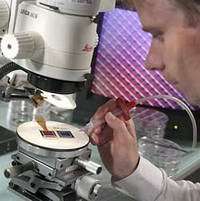Philips shows functional, large-scale demonstrator of its electrowetting-based electronic-paper technology

Philips generated considerable interest at this year's Society for Information Displays in Seattle, USA with a demonstration of its electrowetting-based electronic-paper technology in a 1-inch square, monochrome direct-driven display demo. The demonstrator represents a 50-fold increase in area over earlier prototypes and clearly shows the scalability of this novel, low-power display technology to larger areas.
The advances presented at SID 2004 come primarily from improvements in the large-area reliability of the insulation material, the development of an automated pixel-filling process and improved sealing techniques. In addition, the pixel dimension has been scaled down to a resolution of 160 ppi, resulting in a significant increase in pixel count, which exceeds 11,000 pixels in the current 1-inch display.
Announced last year and also the subject of the cover article in the September 25, 2003 issue of Nature, Philips' electrowetting-based electronic paper technology offers important advantages over other electronic-paper technologies currently under development. Not only does it provide sufficient speed to display moving video (with a response time less that 10 ms), it also offers a unique path towards full-colour displays with a colour brightness of twice that of any other emerging reflective display technology and at least four times that of current reflective liquid-crystal displays.
The technology is based on the micro control of fluid motion by an applied voltage. Oil containing a dye is confined between a layer of water and a hydrophobic (water-repellent) coating on an electrode. With no voltage applied, the oil naturally forms a barrier layer between the water and the hydrophobic coating to create a coloured pixel. When a (low) voltage is applied between the electrode and the water, the interfacial tension between the water and the coating changes. As a result, the stacked state is no longer the lowest energy state, causing the water to move the oil aside. This results in a partly transparent pixel or, where a reflective white surface is used under the switchable element, a white pixel. Because of the small size of the pixel, the eye sees only the average reflection. The result is a high-brightness, high-contrast switchable element which forms the basis of the reflective display.
In contrast to other reflective display technologies which use R,G and B filters or alternating segments of the three primary colours, effectively resulting in only one third of the display reflecting light in the desired colour, electrowetting allows for a system in which one sub-pixel is able to switch two different colours independently. This allows two thirds of the display area to be available to reflect light in any desired colour, effectively doubling the colour brightness compared with other reflective displays. This is achieved by building up a pixel with a stack of two independently-controllable coloured oil films plus a colour filter. The colours used are cyan, magenta and yellow, creating a so-called subtractive colour-mixing system comparable to that used in the printing industry. Moreover, in contrast to LCD, no polarizers are needed resulting in a further factor of two gain in brightness.
Electrowetting has proven to be one of the most effective technologies for fast, micron-level control of fluid motion and is rapidly finding application in a host of areas including the biomedical field, micro pumps and variable-focus lenses. Philips' electronic paper is one further example of this novel technology that is expected to find application in digital camcorders, portable outdoor equipment and other applications requiring low-power reflective displays capable of reproducing bright contrast-rich images with full colour and high-speed video.
The original press release can be found here.




















